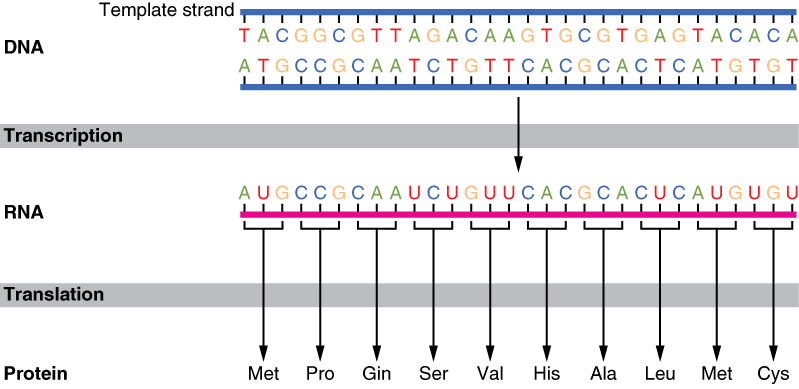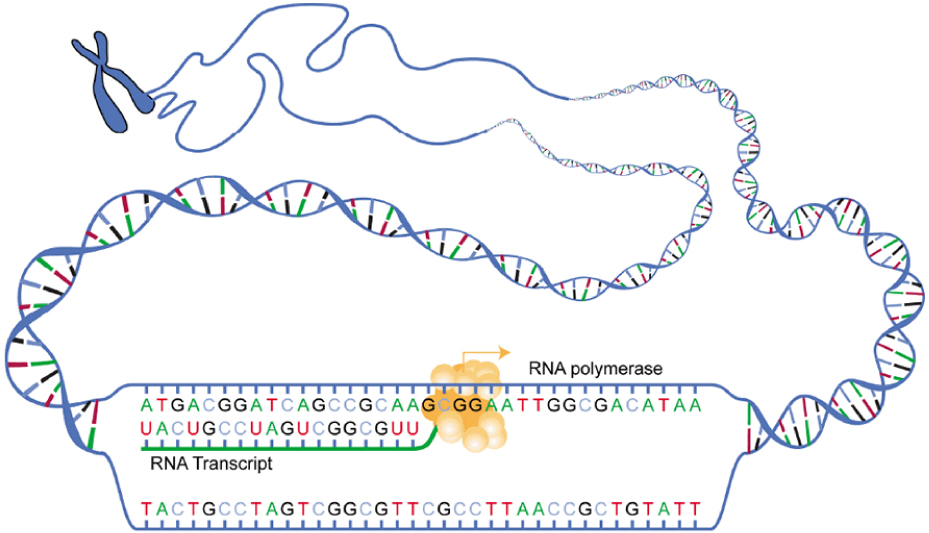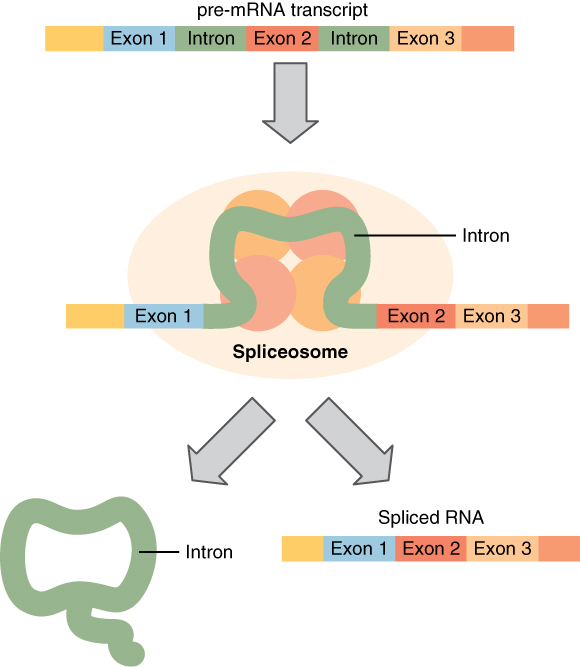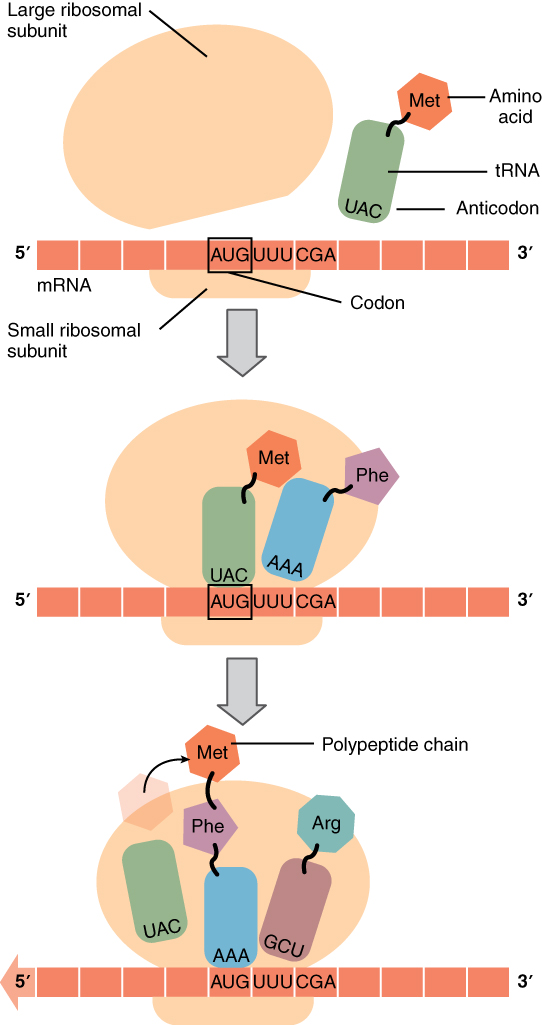The Process of Reading an Mrna Molecule and Synthesize a Protein Is Called What?
The Cellular Level of Organization
Poly peptide Synthesis
Learning Objectives
By the terminate of this section, you will be able to:
- Explicate how the genetic code stored within Dna determines the protein that will form
- Describe the process of transcription
- Describe the process of translation
- Talk over the function of ribosomes
It was mentioned earlier that Deoxyribonucleic acid provides a "blueprint" for the prison cell structure and physiology. This refers to the fact that DNA contains the information necessary for the jail cell to build ane very important blazon of molecule: the protein. Nearly structural components of the prison cell are made up, at least in part, by proteins and virtually all the functions that a prison cell carries out are completed with the assistance of proteins. One of the nigh important classes of proteins is enzymes, which help speed up necessary biochemical reactions that take place within the cell. Some of these critical biochemical reactions include building larger molecules from smaller components (such as occurs during Deoxyribonucleic acid replication or synthesis of microtubules) and breaking downward larger molecules into smaller components (such as when harvesting chemic energy from nutrient molecules). Whatever the cellular procedure may be, information technology is almost sure to involve proteins. Just every bit the cell's genome describes its total complement of Dna, a cell'due south proteome is its full complement of proteins. Protein synthesis begins with genes. A gene is a functional segment of Dna that provides the genetic information necessary to build a protein. Each particular gene provides the code necessary to construct a item poly peptide. Factor expression, which transforms the information coded in a gene to a final gene product, ultimately dictates the construction and office of a cell by determining which proteins are made.
The estimation of genes works in the post-obit way. Remember that proteins are polymers, or chains, of many amino acid building blocks. The sequence of bases in a gene (that is, its sequence of A, T, C, G nucleotides) translates to an amino acid sequence. A triplet is a department of iii Dna bases in a row that codes for a specific amino acrid. Similar to the way in which the 3-letter of the alphabet lawmaking d-o-g signals the epitome of a dog, the three-alphabetic character DNA base code signals the use of a detail amino acid. For example, the DNA triplet CAC (cytosine, adenine, and cytosine) specifies the amino acid valine. Therefore, a gene, which is composed of multiple triplets in a unique sequence, provides the code to build an entire protein, with multiple amino acids in the proper sequence ((Figure)). The machinery by which cells turn the DNA code into a protein product is a two-pace process, with an RNA molecule as the intermediate.
The Genetic Lawmaking
DNA holds all of the genetic data necessary to build a prison cell'south proteins. The nucleotide sequence of a gene is ultimately translated into an amino acrid sequence of the factor's corresponding protein.

From Deoxyribonucleic acid to RNA: Transcription
Dna is housed inside the nucleus, and protein synthesis takes place in the cytoplasm, thus in that location must exist some sort of intermediate messenger that leaves the nucleus and manages poly peptide synthesis. This intermediate messenger is messenger RNA (mRNA), a single-stranded nucleic acid that carries a re-create of the genetic code for a single gene out of the nucleus and into the cytoplasm where it is used to produce proteins.
There are several unlike types of RNA, each having different functions in the prison cell. The structure of RNA is like to Deoxyribonucleic acid with a few small exceptions. For one thing, unlike DNA, most types of RNA, including mRNA, are single-stranded and contain no complementary strand. 2d, the ribose sugar in RNA contains an boosted oxygen atom compared with Deoxyribonucleic acid. Finally, instead of the base thymine, RNA contains the base uracil. This means that adenine will always pair up with uracil during the protein synthesis process.
Gene expression begins with the procedure called transcription, which is the synthesis of a strand of mRNA that is complementary to the gene of interest. This process is called transcription considering the mRNA is like a transcript, or copy, of the gene's Dna code. Transcription begins in a mode somewhat like Dna replication, in that a region of Deoxyribonucleic acid unwinds and the two strands dissever, nonetheless, but that modest portion of the Dna will be dissever apart. The triplets within the gene on this section of the DNA molecule are used every bit the template to transcribe the complementary strand of RNA ((Effigy)). A codon is a three-base sequence of mRNA, so-called because they directly encode amino acids. Like DNA replication, in that location are three stages to transcription: initiation, elongation, and termination.
Transcription: from DNA to mRNA
In the first of the two stages of making protein from DNA, a gene on the DNA molecule is transcribed into a complementary mRNA molecule.

Stage 1: Initiation. A region at the beginning of the factor called a promoter—a item sequence of nucleotides—triggers the start of transcription.
Stage two: Elongation. Transcription starts when RNA polymerase unwinds the Deoxyribonucleic acid segment. I strand, referred to as the coding strand, becomes the template with the genes to be coded. The polymerase then aligns the correct nucleic acid (A, C, Thou, or U) with its complementary base on the coding strand of DNA. RNA polymerase is an enzyme that adds new nucleotides to a growing strand of RNA. This process builds a strand of mRNA.
Phase iii: Termination. When the polymerase has reached the end of the gene, one of three specific triplets (UAA, UAG, or UGA) codes a "stop" signal, which triggers the enzymes to terminate transcription and release the mRNA transcript.
Before the mRNA molecule leaves the nucleus and proceeds to poly peptide synthesis, it is modified in a number of ways. For this reason, it is often called a pre-mRNA at this stage. For example, your Dna, and thus complementary mRNA, contains long regions chosen non-coding regions that exercise not code for amino acids. Their function is notwithstanding a mystery, but the process chosen splicing removes these non-coding regions from the pre-mRNA transcript ((Figure)). A spliceosome—a construction composed of various proteins and other molecules—attaches to the mRNA and "splices" or cuts out the non-coding regions. The removed segment of the transcript is called an intron. The remaining exons are pasted together. An exon is a segment of RNA that remains later on splicing. Interestingly, some introns that are removed from mRNA are non ever non-coding. When different coding regions of mRNA are spliced out, different variations of the protein will eventually result, with differences in construction and function. This process results in a much larger multifariousness of possible proteins and protein functions. When the mRNA transcript is set up, it travels out of the nucleus and into the cytoplasm.
Splicing DNA
In the nucleus, a structure called a spliceosome cuts out introns (noncoding regions) within a pre-mRNA transcript and reconnects the exons.

From RNA to Protein: Translation
Like translating a book from one language into another, the codons on a strand of mRNA must exist translated into the amino acrid alphabet of proteins. Translation is the process of synthesizing a chain of amino acids called a polypeptide. Translation requires two major aids: outset, a "translator," the molecule that volition conduct the translation, and second, a substrate on which the mRNA strand is translated into a new protein, like the translator's "desk-bound." Both of these requirements are fulfilled by other types of RNA. The substrate on which translation takes identify is the ribosome.
Think that many of a prison cell's ribosomes are plant associated with the rough ER, and bear out the synthesis of proteins destined for the Golgi apparatus. Ribosomal RNA (rRNA) is a type of RNA that, together with proteins, composes the construction of the ribosome. Ribosomes be in the cytoplasm as two singled-out components, a small and a large subunit. When an mRNA molecule is ready to exist translated, the two subunits come up together and attach to the mRNA. The ribosome provides a substrate for translation, bringing together and adjustment the mRNA molecule with the molecular "translators" that must decipher its code.
The other major requirement for protein synthesis is the translator molecules that physically "read" the mRNA codons. Transfer RNA (tRNA) is a type of RNA that ferries the appropriate corresponding amino acids to the ribosome, and attaches each new amino acrid to the last, building the polypeptide chain one-past-1. Thus tRNA transfers specific amino acids from the cytoplasm to a growing polypeptide. The tRNA molecules must exist able to recognize the codons on mRNA and match them with the right amino acid. The tRNA is modified for this office. On one end of its structure is a binding site for a specific amino acid. On the other end is a base sequence that matches the codon specifying its item amino acid. This sequence of three bases on the tRNA molecule is chosen an anticodon. For example, a tRNA responsible for shuttling the amino acid glycine contains a binding site for glycine on one end. On the other end information technology contains an anticodon that complements the glycine codon (GGA is a codon for glycine, and so the tRNAs anticodon would read CCU). Equipped with its particular cargo and matching anticodon, a tRNA molecule can read its recognized mRNA codon and bring the corresponding amino acrid to the growing chain ((Figure)).
Translation from RNA to Protein
During translation, the mRNA transcript is "read" by a functional complex consisting of the ribosome and tRNA molecules. tRNAs bring the appropriate amino acids in sequence to the growing polypeptide chain by matching their anti-codons with codons on the mRNA strand.

Much like the processes of Dna replication and transcription, translation consists of three main stages: initiation, elongation, and termination. Initiation takes place with the binding of a ribosome to an mRNA transcript. The elongation phase involves the recognition of a tRNA anticodon with the next mRNA codon in the sequence. One time the anticodon and codon sequences are bound (remember, they are complementary base pairs), the tRNA presents its amino acid cargo and the growing polypeptide strand is attached to this next amino acid. This zipper takes place with the assist of various enzymes and requires energy. The tRNA molecule then releases the mRNA strand, the mRNA strand shifts one codon over in the ribosome, and the next appropriate tRNA arrives with its matching anticodon. This process continues until the final codon on the mRNA is reached which provides a "stop" message that signals termination of translation and triggers the release of the complete, newly synthesized protein. Thus, a factor within the Deoxyribonucleic acid molecule is transcribed into mRNA, which is then translated into a poly peptide product ((Figure)).
From DNA to Poly peptide: Transcription through Translation
Transcription within the cell nucleus produces an mRNA molecule, which is modified and then sent into the cytoplasm for translation. The transcript is decoded into a protein with the help of a ribosome and tRNA molecules.

Unremarkably, an mRNA transcription will be translated simultaneously by several adjacent ribosomes. This increases the efficiency of poly peptide synthesis. A single ribosome might interpret an mRNA molecule in approximately one minute; so multiple ribosomes aboard a unmarried transcript could produce multiple times the number of the aforementioned poly peptide in the same minute. A polyribosome is a string of ribosomes translating a unmarried mRNA strand.
Lookout man this video to larn about ribosomes. The ribosome binds to the mRNA molecule to start translation of its code into a poly peptide. What happens to the small and large ribosomal subunits at the cease of translation?
Affiliate Review
Dna stores the information necessary for instructing the cell to perform all of its functions. Cells use the genetic code stored within DNA to build proteins, which ultimately determine the construction and function of the cell. This genetic code lies in the particular sequence of nucleotides that make up each gene along the DNA molecule. To "read" this code, the jail cell must perform two sequential steps. In the showtime footstep, transcription, the DNA code is converted into a RNA code. A molecule of messenger RNA that is complementary to a specific factor is synthesized in a process similar to DNA replication. The molecule of mRNA provides the code to synthesize a protein. In the process of translation, the mRNA attaches to a ribosome. Adjacent, tRNA molecules shuttle the advisable amino acids to the ribosome, one-past-i, coded by sequential triplet codons on the mRNA, until the protein is fully synthesized. When completed, the mRNA detaches from the ribosome, and the protein is released. Typically, multiple ribosomes adhere to a single mRNA molecule at once such that multiple proteins tin be manufactured from the mRNA concurrently.
Interactive Link Questions
Watch this video to learn about ribosomes. The ribosome binds to the mRNA molecule to start translation of its lawmaking into a protein. What happens to the pocket-sized and large ribosomal subunits at the stop of translation?
They split up and motion and are free to join translation of other segments of mRNA.
Review Questions
Which of the following is not a departure between DNA and RNA?
- DNA contains thymine whereas RNA contains uracil
- Deoxyribonucleic acid contains deoxyribose and RNA contains ribose
- Deoxyribonucleic acid contains alternate sugar-phosphate molecules whereas RNA does not contain sugars
- RNA is single stranded and Deoxyribonucleic acid is double stranded
Transcription and translation take place in the ________ and ________, respectively.
- nucleus; cytoplasm
- nucleolus; nucleus
- nucleolus; cytoplasm
- cytoplasm; nucleus
How many "letters" of an RNA molecule, in sequence, does information technology have to provide the lawmaking for a single amino acid?
- ane
- 2
- 3
- 4
Which of the following is not made out of RNA?
- the carriers that shuffle amino acids to a growing polypeptide strand
- the ribosome
- the messenger molecule that provides the lawmaking for protein synthesis
- the intron
B
Critical Thinking Questions
Briefly explain the similarities between transcription and Dna replication.
Transcription and DNA replication both involve the synthesis of nucleic acids. These processes share many common features—especially, the similar processes of initiation, elongation, and termination. In both cases the DNA molecule must exist untwisted and separated, and the coding (i.due east., sense) strand volition be used as a template. Also, polymerases serve to add nucleotides to the growing Deoxyribonucleic acid or mRNA strand. Both processes are signaled to terminate when completed.
Contrast transcription and translation. Name at to the lowest degree 3 differences betwixt the two processes.
Transcription is really a "copy" process and translation is really an "interpretation" process, because transcription involves copying the Deoxyribonucleic acid message into a very similar RNA message whereas translation involves converting the RNA bulletin into the very different amino acid message. The ii processes too differ in their location: transcription occurs in the nucleus and translation in the cytoplasm. The mechanisms by which the two processes are performed are as well completely different: transcription utilizes polymerase enzymes to build mRNA whereas translation utilizes different kinds of RNA to build protein.
Glossary
- anticodon
- sequent sequence of iii nucleotides on a tRNA molecule that is complementary to a specific codon on an mRNA molecule
- codon
- consecutive sequence of 3 nucleotides on an mRNA molecule that corresponds to a specific amino acid
- exon
- ane of the coding regions of an mRNA molecule that remain afterwards splicing
- cistron
- functional length of DNA that provides the genetic information necessary to build a protein
- factor expression
- active interpretation of the information coded in a factor to produce a functional gene product
- intron
- not-coding regions of a pre-mRNA transcript that may be removed during splicing
- messenger RNA (mRNA)
- nucleotide molecule that serves as an intermediate in the genetic lawmaking betwixt DNA and protein
- polypeptide
- chain of amino acids linked by peptide bonds
- polyribosome
- simultaneous translation of a single mRNA transcript by multiple ribosomes
- promoter
- region of Dna that signals transcription to begin at that site within the cistron
- proteome
- full complement of proteins produced by a cell (determined by the jail cell'south specific factor expression)
- ribosomal RNA (rRNA)
- RNA that makes up the subunits of a ribosome
- RNA polymerase
- enzyme that unwinds DNA and then adds new nucleotides to a growing strand of RNA for the transcription phase of protein synthesis
- spliceosome
- circuitous of enzymes that serves to splice out the introns of a pre-mRNA transcript
- splicing
- the process of modifying a pre-mRNA transcript by removing certain, typically non-coding, regions
- transcription
- process of producing an mRNA molecule that is complementary to a particular gene of Dna
- transfer RNA (tRNA)
- molecules of RNA that serve to bring amino acids to a growing polypeptide strand and properly identify them into the sequence
- translation
- process of producing a protein from the nucleotide sequence code of an mRNA transcript
- triplet
- consecutive sequence of iii nucleotides on a Dna molecule that, when transcribed into an mRNA codon, corresponds to a detail amino acid
Source: https://opentextbc.ca/anatomyandphysiologyopenstax/chapter/protein-synthesis/
0 Response to "The Process of Reading an Mrna Molecule and Synthesize a Protein Is Called What?"
Post a Comment